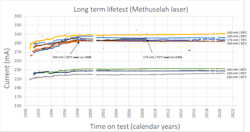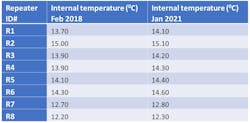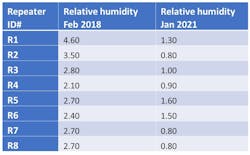Under the Hood of Submarine Repeaters
With the introduction of erbium-doped fiber amplifiers in both terrestrial and submarine transmission systems, some 20 years ago, the subsea telecom industry was confronted with a unique and demanding challenge: How to meet the requirement of customers with expectations of a 25-year life cycle, without all the same financial penalties of earlier coaxial and optically regenerated links?
The principal concern at the time was the relatively unproven optical pumps, as most of the electronic components were already in use across a wide range of applications, including aerospace. There was only one obvious approach, the use of a highly accelerated life test, based on a framework originally introduced by Arrhenius in the 19th century and extended to other non-chemical applications in succeeding years. The key to this approach is to demonstrate through pre-reliability tests that the device materials do not go through any phase or chemical changes at the highly accelerated temperatures, validating the Arrhenius lifetime extrapolation method and giving users confidence that the product could be used for 25 years, after less than six months’ accelerated testing. The early results, though technically sound, did not initially convince the network service providers, which led to the introduction of optical amplifier designs with pump redundancy.
Since then, there has been a strong interest in getting a better understanding of the actual aging characteristics of the pump lasers in real operating conditions. To answer this question, we at Xtera have equipped our repeaters with a range of sensors and linked them to our supervisory system. Below, we share the results from two installed subsea communications links, thanks to an operator who provided the data.
In prior articles, which included findings on the effects of low noise figure Raman techniques,1,2 we reported on the operation of the 14xx-nm Raman pumps over time, but these pumps do not have a history of being used in subsea optical links. Instead, amplifiers in subsea repeaters use 980-nm pumps, which are the most critical components of the amplifier in determining the performance and longevity of subsea repeaters. Highly reliable subsea repeaters are critical in maintaining uninterrupted revenue-generating services and preventing costly subsea equipment repairs. For this reason, subsea amplifiers are designed with redundancy and highly reliable components, including the 980-nm laser diodes that pump the amplifiers. We obtained data for two subsea links, which we refer to as Systems 1 and 2, for five and three years respectively. System 2 is longer than System 1 and therefore includes more subsea repeaters.
The 980-nm pumps in these two systems were supplied by II-VI Inc. They have demonstrated zero failures to date, translating into a failure rate of ~5 FIT, an impressive number that will continue to decrease over time as the lasers continue to operate without failure. The comprehensive set of monitoring data that we obtained from the two subsea links provides further insight into the actual aging mechanisms at play, which may form the basis for future predictive analysis methodologies.
Zener diodes
Zener diodes, or similar devices, continuously adjust the flow of current to maintain a fixed voltage across all elements of the subsea repeater, compensating for changes due to the wide range of operating conditions and system aging over time. The magnitude of this current is reported by the system and is the primary indicator of the health of the subsea amplifier. Note that the current drawn on the first day of operation, or at the “start-of-life” (SOL), is much lower than the current drawn at the “end-of-life” (EOL), but since the power delivered to the subsea amplifier remains constant over time, the “unused” current at SOL translates into lost power in the form of heat dissipated in the subsea repeater.
The current data in Table 1 shows that there is no measurable change in System 1 over a period of almost five years, indicating a very slow aging process, with changes far lower than the system design budget allows.
980-nm pump laser diodes
The 980-nm pump laser diodes and their drive circuitry provide direct access to a multiplicity of valuable data. Xtera’s subsea systems leverage that available data. The systems are designed to monitor all the embedded 980-nm laser diodes for pump output power (mW), pump current (mA), pump voltage (mV), and pump temperature (°C). The supervisory system offers several possible operating modes of the pump lasers: constant pump current, constant pump power, constant amplifier output power, and constant aggregate pump power (from two or more coupled pumps).
In general, any aging of pumps can be observed through an increase in current required to achieve the same pump output power.3 The mean time to failure (MTTF) for a laser diode is often defined as the time over which the pump current increases to 120% of SOL values at the same pump output power. Thus, the monitoring of this pump data allows the operator to estimate the health and remaining lifetime of the pumps over time. However, with the pump redundancy built into the system design, each pump is typically operated at about 50% of rated value, thereby significantly increasing the lifetime of the pumps, which explains the small change in current consumption over time shown in Table 1. It is only under a pump failure condition that the second pump current is operated near 100%. Note that the systems discussed here have two coupled pumps in each amplifier, but other designs build in even more redundancy with more than two coupled pumps.
A review of the available data indicated that there were no significant changes in either System 1 or System 2 to date. This real-life system demonstration is in line with a long-term accelerated life-test of early generation laser diodes, referred to as “Methuselah” lasers, as shown in Figure 1. These lasers have run for about 30 years, which is equivalent to several system lifetimes at “use” conditions. Figure 1 extends the dataset presented previously (in Reference 3) and demonstrates the great stability of the underlying technology.
Over the intervening years II-VI has invested significantly in the development of that underlying technology, enhancing both chip and module designs, with latest generation submarine pump lasers now providing significant improvements in performance, efficiency, reliability, and stability over their operating life at powers of up to 800 mW. These developments enable more complex pumping schemes used in today’s highest capacity, high-fiber-count submarine systems.
Pressure
In a previous supervisory article,1 we discussed the importance of monitoring over time the proper hermetic sealing of the system with pressure monitoring. To achieve this, Xtera designed a mechanical enclosure that creates a small increase of pressure when the bulkhead is pressed into place. Any changes of the pressure sensor readings beyond the expected range during normal operation would indicate a lack of gas tightness and the loss of integrity in the enclosure’s hermetic seal. Once installed, the pressure within the repeater enclosure varies within an expected range as a function of ambient temperature, as shown in Table 2 for System 2.
Temperature
The internal temperatures inside Xtera’s repeater are measured at several positions. Table 3 shows the temperatures measured after the repeaters settled post-installation and then over a three-year time interval. The measurement variations over the three-year period were within the range of measurement error, allowing us to conclude that the temperature within the system remained extremely stable. Repeater R2 is known to be installed in a slightly warmer location, based on findings during the marine survey, and this is reflected in the data.
Humidity
The only parameter that has varied since the repeaters were built has been the relative humidity. The repeaters contain an assortment of getters (something used to absorb any gas that may be present), both a desiccant and a type of zeolite that absorbs any hydrogen that may be present. These getters act in tandem and improve on an already excellent starting environment, as can be seen in Table 4. As expected, the environment improves over time, with both moisture and hydrogen (which cannot be measured) trending lower, ensuring very high system reliability.
Concluding remarks
As described previously,1 Xtera’s repeaters embed a number of sensors that enable sophisticated active supervisory management. Some of the features originally embedded to facilitate development and qualification became a useful tool for our customers, providing both information and reassurance.
While we operate the pumps at well below the maximum-rated power to provide life margin, the most important information from this study pertains to the 980-nm pumps and the current monitoring at the Zener diodes. This data indicates that no measurable aging has been detected in the 980-nm pumps and provides evidence of the stability of the underlying pump laser technology. Due to their slow aging, 980-nm pumps draw less power, justifying both pump-combining designs and lowering the need for failure mitigation features in the design of future products.
Prudent selection of Zener diodes also compensates for any degradation. The early data shows that there was no measurable change in the systems analyzed and there is plenty of margin left for the remaining life of the system.
The question remains, is it worth monitoring all these parameters? With repair costs increasing significantly, and the ship-to-system ratio changing adversely, it is increasingly critical that operators be able to plan ahead for repair operations. Monitoring parameters can provide early warnings to operators at low incremental costs, making them compelling features to network service providers.
References
1. Submarine Telecoms Forum magazine, issue 118 Global Capacity. “Last Active Person Standing,” Stuart Barnes. https://subtelforum.com/the-last-active-person-standing/
2. White paper “A little bit of Raman makes the repeater go a long way,” Stuart Barnes, Wayne Pelouch, and Nigel Taylor. https://www.xtera.com/wp-content/uploads/2021/04/Raman-makes-the-Repeater-go-a-long-way.pdf
3. Toby Strite and Christoph Harder, III-V Review, Vol. 12 No. 1, 1999.
Contributors
Simon Loten, vice president and general manager, pump lasers, II-VI Inc., and Tomas Pliska, manager, product engineering, pump products, II-VI Inc.
Authors
Stuart Barnes is chairman of Xtera. After graduating from Queen Mary College, London University with BSc (Hons) and PhD in Engineering, Barnes joined Standard Telecommunications Ltd., the Research Subsidiary of STC. After seven years in research, including three years supporting the development of STC Submarine Systems’ first optical repeater, he then was involved in turnaround activities in the terrestrial fiber and cable divisions (market share increased from 5% to 50%). Then, in STC Submarine Systems, he went on to become technical director in 1995, where he was responsible for the development of STC’s second optical repeater.
After the acquisition of the Submarine Group by Alcatel, Barnes moved to Paris to head up Alcatel’s Optical Recherche Group. In 1999 he founded Ilotron (UK); after a short period with Atlas Venture as an ER he co-founded Azea Networks in 2001, which merged with Xtera Communications Inc. in 2007. He is visiting professor at Southampton University and an adviser to the School of Photonics, Aston University.
Wayne Pelouch is vice president of Photonics at Xtera. Wayne Pelouch received his B.A. degree in Physics (Honors) and B.S. degree from Northwestern University in 1987, and his Ph.D. degree in Applied Physics from Cornell University in 1992. His thesis covered ultrafast lasers and nonlinear optical processes with applications in semiconductor physics. After graduation he joined the University of New Mexico/Air Force Research Labs in Albuquerque, NM, and then worked for the Lions Eye Institute in Perth, Australia as a laser physicist. Subsequently, he joined Coherent Technologies (Lafayette, CO), where he was principal investigator on a number of SBIR programs related to waveguide laser and amplifier technology. Dr. Pelouch joined Xtera Communications in 2001; in his current role there he leads all photonics activities including research, product development, and system network design. He has authored numerous publications and patents related to fiber optics and amplifier technology.
About the Author
Stuart Barnes and Wayne Pelouch
Stuart Barnes is chairman of Xtera. After graduating from Queen Mary College, London University with BSc (Hons) and PhD in Engineering, Barnes joined Standard Telecommunications Ltd., the Research Subsidiary of STC. After seven years in research, including three years supporting the development of STC Submarine Systems’ first optical repeater, he then was involved in turnaround activities in the terrestrial fiber and cable divisions (market share increased from 5% to 50%). Then, in STC Submarine Systems, he went on to become technical director in 1995, where he was responsible for the development of STC’s second optical repeater.
After the acquisition of the Submarine Group by Alcatel, Barnes moved to Paris to head up Alcatel’s Optical Recherche Group. In 1999 he founded Ilotron (UK); after a short period with Atlas Venture as an ER he co-founded Azea Networks in 2001, which merged with Xtera Communications Inc. in 2007. He is visiting professor at Southampton University and an adviser to the School of Photonics, Aston University.
Wayne Pelouch is vice president of Photonics at Xtera. Wayne Pelouch received his B.A. degree in Physics (Honors) and B.S. degree from Northwestern University in 1987, and his Ph.D. degree in Applied Physics from Cornell University in 1992. His thesis covered ultrafast lasers and nonlinear optical processes with applications in semiconductor physics. After graduation he joined the University of New Mexico/Air Force Research Labs in Albuquerque, NM, and then worked for the Lions Eye Institute in Perth, Australia as a laser physicist. Subsequently, he joined Coherent Technologies (Lafayette, CO), where he was principal investigator on a number of SBIR programs related to waveguide laser and amplifier technology. Dr. Pelouch joined Xtera Communications in 2001; in his current role there he leads all photonics activities including research, product development, and system network design. He has authored numerous publications and patents related to fiber optics and amplifier technology.





